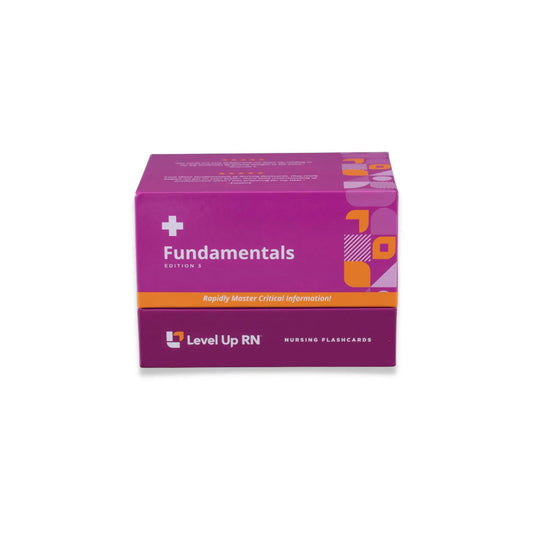Fundamentals - Community Health, part 8: Epidemiology
Updated: Ellis ParkerEpidemiology including the epidemiologic triangle. This triangle consists of the agent, host, and environment. Ellis then discusses other important terms in epidemiology like incidence, prevalence, attack rate, endemic, epidemic, and pandemic.
Full Transcript: Fundamentals - Community Health, part 8: Epidemiology
Full Transcript: Fundamentals - Community Health, part 8: Epidemiology
Hi, I'm Ellis with Level Up RN. In this video, we'll be continuing our discussion on community health by moving into epidemiology, which we actually have spanned across two cards. We'll also go into nationally notifiable diseases and bioterrorism. Now, all these cards are found in the community health section of our Fundamentals of Nursing flashcard deck. So if you have the deck, grab the cards, and you can follow along with me, which you might want to do because there's a lot of words on these cards. If you don't have the deck, you should definitely check us out at leveluprn.com. After the content, make sure you stay tuned because I have a couple of questions to check your knowledge. Epidemiology is the study of the distribution, causes, and risk factors of health-related events in a specific population. The epidemiologic triangle is a model used by scientists to study health-based problems. Being called a triangle, I think we can all come to the conclusion that there are three parts to it: the agent, the host, and the environment. The agent is what caused the disease, whether that's bacteria or viruses or a pollutant. The host is the infected organism, so humans or animals. And the environment includes external factors that allows the disease to spread, and that might include contaminated water or warm weather.
There are quite a few terms that we need to understand when we are thinking about epidemiology, the first being incidence. Incidence is the number of new cases of a disease or injury in a population during a specific period of time. Prevalence is the number of new and preexisting cases, so all current cases in a population during a specific time. This figure does not include patients who have died from that disease or injury. Attack rate is the term used to describe the number of new cases divided by the total population. An endemic is a disease that is just typically present within a particular population or a certain geographic area. It is normal for certain diseases to be present at a certain level within a given population or geographic area. Where it gets concerning is when we start needing to use the words like epidemic. An epidemic is an increase in a number of cases beyond what is normally expected of that disease within the population or geographic area. And then one step above epidemic is pandemic. And that's when the disease breaks the boundaries of countries or continents and spreads into much wider populations and geographic areas. And I think we can all remember vividly in our very recent history, the pandemic of COVID-19, and how it affected a large number of individuals across countries and continents. A critical component of epidemiology are the nationally notifiable diseases. This is a collection of diseases that are monitored by the Nationally Notifiable Diseases Surveillance System in order to prevent the occurrence and/or the spread of these diseases. Now, this is a huge list, and if you would like to read them all, please check them out at cdc.gov. I am going to convey a selection of them. We chose ones that we felt that were either the most prevalent or the most common or the most tested on. And I'm not even going to pretend like I have them memorized. I'm going to read the key diseases off our card to use so that you're familiar with what some of them might be.
They include anthrax, botulism, chlamydia, cholera, COVID-19, diphtheria, giardiasis, gonorrhea, H influenzae or the flu, hantavirus, hepatitis A, B, and C, HIV, lead poisoning, Lyme disease, measles, meningococcal disease, mumps, pertussis, rubella, rabies, salmonella, Shiga toxin-producing E coli, smallpox, syphilis, tetanus, tuberculosis, varicella, viral hemorrhagic fevers, and Zika virus. So again, a full list of the nationally notifiable diseases can be found at cdc.gov. So the key part to this list of diseases is that they are reportable. We're required to report them. So if a person is diagnosed with one of these, then the local health department is going to tell the state health department, and the state health department then has to report it to the CDC so that it can be monitored and tracked. Some of the diseases that I just listed off in our list of nationally notifiable diseases can and have unfortunately been used in acts of bioterrorism. Bioterrorism is the deliberate release of biologic agents with the intent to harm or kill individuals in the general population. There are a lot of different agents that can be used for this, but we specifically go over to on this card, anthrax and smallpox.
Anthrax is a deadly infectious disease caused by B anthracis spores. Signs and symptoms of anthrax are fever, shortness of breath, coughing, nausea and vomiting, and diaphoresis. It's treated with antibiotics like ciprofloxacin and doxycycline as well as antitoxins. Smallpox is a deadly infectious disease caused by the variola virus. It was eradicated in 1979, but unfortunately, stockpiles do still exist of the virus, and thus there is a potential threat for a bioterrorism event. The signs and symptoms are fever, as well as a rash that starts in the mouth, and then it moves down the body. Treatment includes administration of the smallpox vaccine, and that hopefully will decrease the severity of the disease process, and antivirals. Other potential agents that can and/or have been used in bioterrorism events include botulism, plague, tularemia, hemorrhagic viruses, for example, Ebola, as well as food and water safety threats. That concludes the content for this video, so let's go ahead and check your knowledge.
What are the three components of the epidemiologic triangle? The triangle is composed of the agent, host, and environment. What are examples of agents in the epidemiologic triangle? An agent can be bacteria, virus, or pollutants. What is the difference between incidence and prevalence in epidemiology? Incidence is the number of new cases, whereas prevalence is the number of current cases, which includes the new cases as well as preexisting ones. What is the reporting process if someone is diagnosed with a nationally notifiable disease? That diagnosis needs to be reported to the local health department who then reports to the state health department, which then reports it to the CDC so that it can be monitored by the Nationally Notifiable Disease Surveillance System. Define bioterrorism. Bioterrorism is the deliberate release of a biologic agent with the intent to harm or kill individuals in the general population. What are the signs and symptoms of anthrax? Anthrax is characterized by fever, shortness of breath, cough, nausea, vomiting, and diaphoresis. Thank you so much for studying with me. I hope that you learned something. In our next video, we'll be wrapping up community health nursing by chatting about management of disasters and triage during mass casualty events.



2 comments
Thank you team level up rn, you guys make learning so easy. Your content is super.
You ROCK, that’s it, you ROCK!